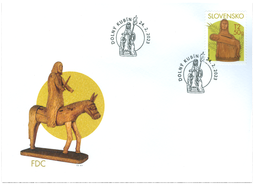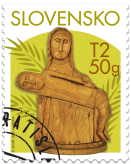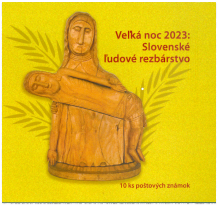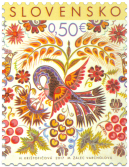787 Date of issue
24.02.2023 Face value
1.20 € Sell price
1.20 €
The paths that lead artists to naive art are diverse, they can be direct or complex. However, what they have in common is that the artist has a spontaneous need to portray the world around them, their dreams and visions, regardless of the universally recognised means of artistic expression. Štefan Siváň senior (1906 – 1995) began his artistic career carving crib figures. They were part of the portable cribs he carried when, as a young man, he went carol-singing over the Christmas and New Year festivities in Slovakia, Moravia and Silesia. He lived his whole life in the village of Babín, in the Horná Orava region. He gradually created a miscellaneous collection of art, both in terms of its topics and means of expression. Today he is considered to be one of the most significant Slovak naive wood carvers and his works of art are also important within the European naive art scene.
Siváň was a farmer and wheelwright. He worked with wood from his childhood. Woodcarving distracted him from his everyday life in a demanding environment and brought him joy, as well as the ability to increase his income. Although his pieces of art follow the folk fine art tradition, the purity and authenticity of his untrained artistic expression allowed him to break away from its anonymity. He mainly depicted the motifs that surrounded him, with which he had a close relationship and knew well. Siváň intuitively shaped wood and turned it into figures of shepherds, farmers and animals. They gradually grew to be of monumental sizes. Besides carvings of subjects of different occupations, his favourite topics included motherhood and family. The folk tradition of the Orava region was completed with figures of musicians and thieves, in particular, Jánošik. Siváň also depicted religious scenes, especially those depicting Jesus Christ and the Virgin Mary. They were based on the iconography and morphology of folk woodcarving. There are several variants of his portrayal of Pieta in the collection in the Orava Gallery. They show the specific features of Siváň’s carving style – stylised block forms, naive spatial skills and those that depict anatomy, easiness and the poetics of expression. Their distinct nature also comes from Siváňʼs deep insight into a particular topic and his ability to communicate it as a simple man with an honest faith.
Dagmar Adamusová
Show lessSimilar products
839 Date of issue
21.02.2025
760 Date of issue
04.03.2022
656 Date of issue
27.02.2018
632 Date of issue
24.03.2017
607 Date of issue
26.02.2016
583 Date of issue
06.03.2015
559 Date of issue
10.03.2014
534 Date of issue
01.03.2013
513 Date of issue
09.03.2012
492 Date of issue
04.03.2011
470 Date of issue
26.02.2010
450 Date of issue
27.02.2009
© 2025 POFIS - Postal philatelic service. All rights reserved























